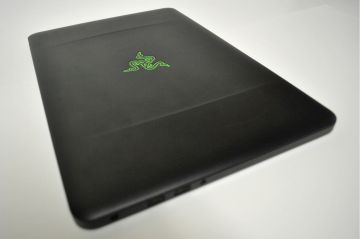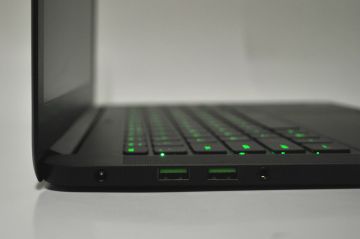PC makers aren’t known to swing for the fences when they build new laptops. The heart of their business isn’t about making the best laptop they possibly can. It’s about checking the right boxes, hitting the right price points and staking out a good spot on the shelves at Best Buy. You’ll find plenty of good enough Windows-based laptops these days, but if you’re willing to pay for a laptop in pursuit of perfection–well, there’s a reason Apple dominates the premium PC market.
Razer, however, is in an unusual position. The company’s bread and butter isn’t laptops and desktops, but peripherals like mouses and keyboards, specifically aimed at PC gamers. Razer is unencumbered by the need to sell PCs to the masses. Instead, every so often when the company decides to build a PC, it can swing for the fences.
The $1,800-and-up Razer Blade is the company’s latest effort, and a valiant one. It’s a 14-inch laptop built for gaming, but you might not know it from appearances alone. At 0.66 inches thick and cut from a slab of aluminum, the Razer Blade takes some design cues from Apple, but with plenty of its own flourishes. The case is a deep black, with a slight downward contour where Razer’s bright green hydra logo resides. Beneath the razor-thin lid lies a backlit keyboard–the same shade of green, of course–flanked by some surprisingly loud stereo speakers.
We’ve seen other PC makers dabble in unibody aluminum and high-end design before. The thing that makes the Razer Blade different is that it doesn’t sacrifice functionality in pursuit of prettiness. Just check out the spec sheet: a 2.2 GHz quad-core Intel Core i7 Haswell processor, an Nvidia GeForce 765M graphics card with 2 GB of video memory, 8 GB of RAM and a minimum 128 GB of solid state storage.

To put all that another way, the Razer Blade shreds through most of the PC games I tried. In Tomb Raider, the Blade hummed along at 60 frames per second on normal graphics settings, and still managed about 40 frames per second on “Ultra” settings. Far Cry 3 was a bit rougher, as the Blade couldn’t really handle anti-aliasing and didn’t quite hit 60 frames per second on normal settings, but the game was still playable–and beautiful–with graphics settings turned way up.
Even when plugging the Razer Blade into my TV at 1080p resolution, I barely noticed a drop in quality and was still able to hit high frame rates in Hitman: Absolution. Fan noise was always noticeable, but not obnoxiously so. Despite being a fraction of the size of current-generation game consoles, the Razer Blade easily outperformed them.
While it’s no surprise that Razer markets the Blade as a gaming PC, it’s almost a shame to see it get pigeonholed given how well it holds its own as a productivity machine. The Blade’s island-style keys are somewhat looser and more clicky than what you’d find on a MacBook, but not in a bad way. The trackpad is large and covered in glass, with two easy-to-press buttons underneath–eschewing the Apple-inspired trend of clickable trackpads.
I do have two complaints with the trackpad, though: The ability to simulate a right-click by tapping with two fingers is sorely missing, and the cursor was prone to accidental movement, possibly from wonky palm detection. Fortunately, the latter issue didn’t seem to cause any accidental mouse clicks; it was just a distraction as the cursor bounced around while I typed.

Although you might expect weak battery life from such a slim yet powerful laptop, the Blade managed over five hours on about 65% brightness in day-to-day non-gaming use. That’s respectable, but not phenomenal in this new age of 12-hour laptop batteries. (Gaming drained the battery much faster: I was able to squeeze about two hours of play time in before the Blade begged for a charge.)
Still, those are just nitpicks compared to the Razer Blade’s biggest problem, the one thing that holds it back from sheer greatness: its display.
Man, is that screen ugly to look at. I couldn’t find a single viewing angle that provided consistent black levels from top to bottom, and I had to futz with the lid every time I shifted my position just to get an angle that looked halfway decent. Tip the screen a little bit one way or another and everything washes out. I’m not terribly bothered by the resolution of 1600-by-900, which despite being a far cry from Apple’s Retina displays still looks pretty good at normal viewing distances. I couldn’t care less about the lack of a touch screen. It’s just absolutely mind-boggling that Razer would skimp on the quality of the display–the one thing you must work with constantly–in a laptop that otherwise spares no expense.
Whether or not the screen amounts to a dealbreaker depends how much you care about picture quality. What I will say is this: It’s frustrating, but also kind of exciting, how close to perfection Razer has come. I tend to avoid superlatives, but minus this one glaring issue, I could easily declare the Razer Blade to be the best laptop I’ve ever used. And I wouldn’t have to tack on any lame qualifiers like “best Windows laptop” or “best gaming laptop.” Next time, let’s see Razer knock it out the park.

